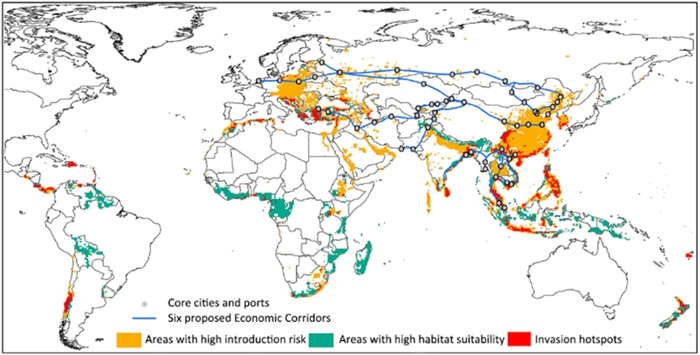Recently, a team led by Prof. LI Yiming from the Institute of Zoology, Chinese Academy of Sciences, conducted a comprehensive study evaluating the invasion risk of global alien vertebrates, to help facilitate the balance between development and conservation for the Belt and Road Initiative (BRI).
This study, published with the title of " Risks of biological invasion on the Belt and Road" in Current Biology (https://www.cell.com/current-biology/fulltext/S0960-9822(18)31670-1), which was online on January 24, 2019.
The Belt and Road Initiative (BRI) proposed by China is regarded as the biggest global development program ever to occur on earth. It involves nearly half of our planet across Asia, Europe, Africa, Oceania and America, covering 77% (27/35) global biodiversity hotspots. Its high expenditure into infrastructure constructions may accelerate trade and transportation and thus promote alien species invasions, which is one primary anthropogenic threat to global biodiversity. The Chinese Government has been expecting that BRI is to be sustainable development paying equal attention to economic development and environmental conservation. Therefore, there is a strong imperative to identify those areas with high invasion risks, and those species with high invasive potentials, to aid in the resource allocation, and development of early, economical, and effective biosecurity, to achieve a balance between development and conservation.
Focusing on 816 global alien vertebrates (98 amphibians, 177 reptiles, 391 birds and 150 mammals), the researchers first quantified introduction risks based on spatial data on trade, passenger numbers and cargo volumes from airports and shipping ports across BRI countries. They then quantified habitat suitability using ecological niche modelling for each of 816 alien vertebrates. Finally, they obtained overall invasion hotspots by overlaying areas with high introduction risk with those with high habitat suitability. The researchers identified a total of 14 invasion hotspots, importantly, majority of which fall along the six proposed Economic Corridors with the proportion of areas in invasion hotspots 1.6 times higher than other regions. Based on their findings, the researchers recommend the initiation of a collaboration project targeting early prevention, strict surveillance, rapid response and effective control of alien species in BRI countries to ensure the sustainable implication of BRI.

BRI areas with high introduction risk, high habitat suitability, and overall invasion hotspot. Blue line shows the six proposed Economic Corridors linking core cities and key ports along traditional international transport routes.

